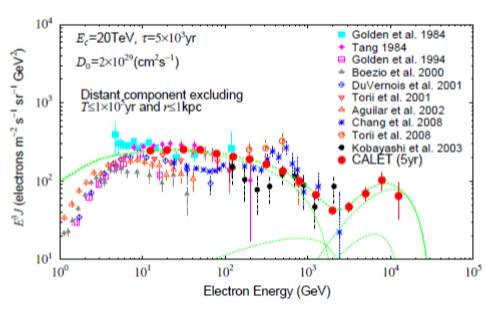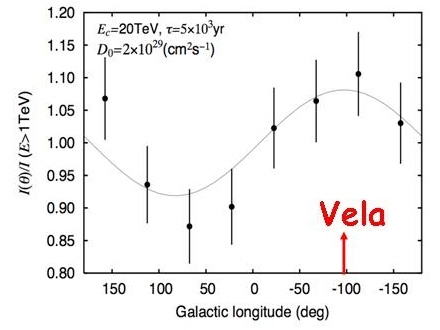“Direct Measurement of the Spectral Structure of Cosmic-Ray Electrons+Positrons in the TeV region with CALET on the International Space Station”, O. Adriani et al., Phys. Rev. Lett. 131, 191001 (2023); https://doi.org/10.1103/PhysRevLett.131.191001.
“High Statistics Measurement of Cosmic-ray Electron and Positron Spectrum from 11 GeV to 4.8 TeV with the Calorimetric Electron Telescope on the International Space Station”, O. Adriani et al., Phys. Rev. Lett. 120, 261102 (2018); https://doi.org/10.1103/PhysRevLett.120.261102.
“Energy Spectrum of Cosmic Ray Electron + Positron from 10 GeV to 3 TeV Observed with the Calorimetric Electron Telescope on the International Space Station”, O. Adriani et al., Phys. Rev. Lett. 119, 181101 (2017); https://journals.aps.org/prl/abstract/10.1103/PhysRevLett.119.181101.
Very High Energy Electrons
The Primary Science for CALET is the investigation of the high energy electron spectrum into the trans-TeV energy range. Of interest here are the questions (1) are we observing “nearby” sources of electrons?, (2) can we detect the “end” of the galactic total electron spectrum?, (3) can we determine an anisotropy for these high energy electrons and try to identify the sources?, and (4) is there any evidence for a dark matter annihilation signature within the electron spectrum? These questions are all the more compelling with the recent results from balloon experiments (BETS, ATIC, PPB-BETS), space experiments (Fermi, PAMELA) and ground based ACT observations (HESS). Compared to the anticipated secondary electron spectrum derived from the current, best galactic propagation code — GALPROP — all of the experiments agree that there is an excess of electrons in the 100’s of GeV to ~1 TeV energy interval, but the details of this excess remain to be defined. The balloon experiments with high energy resolution but low statistics observe a more peaked structure compared to the high statistics but lower resolution space- and ground-based experiments. Beyond ~TeV, HESS data suggest a rapid roll-off in the spectra which is not as evident in the other experiments. There is also the question of whether these high energy events are electrons, positrons, or both, based upon the PAMELA observations of an enhanced positron/total electron ratio from ~10 GeV to 100 GeV.
Explanations have been offered ranging from nearby pulsars producing e+e- pairs, to middle-age supernova remnants, to exotic dark matter particle annihilations, to micro-quasars, and include ideas about our local region of the galaxy being endowed with a larger complement of high energy sources. The current situation cries out for definitive data (as discussed in the Report of the Panel on Particle Astrophysics and Gravitation — Section 8 – of the Astro 2010 Decadal Survey). What is needed is to combine the high resolution capabilities of the balloon experiments with the long exposure time of a space mission, plus exhibit a high level of proton rejection power and small systematic uncertainties. This is what CALET is designed to accomplish.

Figure 1. Anticipated results from a five year CALET mission compared to possible
spectra as calculated by Kobayashi et al. (2003). Note that the flux
is multiplied by E3 to flatten the spectrum..
Some years ago, Kobayashi et al. investigated the “signatures” that might be observed from some nearby supernova remnants (SNR), such as Monogem, Vela, Geminga, over a broad parameter space. They found that such sources could contribute to the electron spectrum (to varying degrees depending upon, mainly, the diffusion coefficient) in the multi-hundred GeV to beyond 20 TeV energy range. The anticipated CALET results are super-posed on one of their prediction plots in Figure 1. The sources shown in green at the bottom are (from left) Monogem, Cygnus Loop and Vela. Figure 1 demonstrates that CALET will have the resolution and the statistics to pin down such effects. Moreover, it, unlike any other experiment, will have the energy reach to see a signature from a Vela-like source, if one exists. Beyond 2 TeV, we anticipate more events from Vela than from the secondary component, so if Vela is not a source, the measured spectrum will drop precipitously — itself an important result.
The predicted CALET data points shown in Figure 1 differ only slightly from those shown in earlier proposals or papers that addressed the earlier, larger version of CALET. The new exposure, smaller by a factor of 2.3, has led us to omit the previous point at ~20 TeV (which contained only 3-4 events) and to plot somewhat larger error bars on the remaining points, although the difference in size of the error bars is imperceptible in the plot except on the two highest-energy points.

Figure 2. Anticipated results from CALET compared to
current data and to models for origin of the excess electrons
in Supernova Remnants (solid) and Pulsars (dashed). The flux is
multiplied by E3
Figure 2 shows the current data from Fermi, HESS, ATIC and PPB-BETS compared to GALPROP predictions (lower curve) plus a model for nearby SNR (solid curve) or Pulsar (dashed curve) sources. These models involve different types of energy cut-offs, assume a source spectrum of E-1.7 and an “age” of ~3 x 105 years. The models reproduce the peaks observed by the balloon experiments plus the increasing positron to total electron ratio reported by PAMELA. The anticipated CALET results are plotted in red for the SNR model. The important point that is illustrated here is that these different models do make predictions that can be used to differentiate between them. In the region >1 TeV, the effects of the different energy cut-offs is observed and CALET will be able to decide between SNR and Pulsar predictions.

Figure 3. Anticipated anisotropy.
Figure 3 illustrates the expected anisotropy for electrons calculated as (maximum intensity – minimum intensity/max.+min.) which is directly related to the electron diffusion coefficient. At low energies the anisotropy is quite small, but increases with increasing energy to become ~10% in the trans-TeV energy range, and this should be detectable. Fermi has not observed such anisotropy, so it may be “seeable” only at very high energy. Moreover, if you introduce a source like Vela (c.f. Figure 1), the source may well be detectable (at > TeV) in a galactic longitude scan, as illustrated in Figure 4. Here the probability of success is not large, but it would be an important discovery.

Figure 4. Anticipate longitudinal profile
assuming Vela as a source of high energy electrons.
There have been many more recent interpretations of the current results (Fig. 2) and space does not permit a complete review. Of interest is the analysis of Profumo, who combined the expected emission from a number of nearby supernova remnants/pulsars both for total electrons and for positrons. This paper was able to combine emission from Geminga, Monogem, Vela, B0355+54, Loop 1 and the Cygnus Loop to obtain an approximate fit to the positron fraction plus the total electron spectrum. As with all models that combine components from different sources, this one also predicts some structure in both the total electron spectrum plus the positron fraction. Such structure can only be observed with an experiment, such as CALET, exhibiting superior energy resolution. Interesting is the prediction that the positron fraction should continue to rise and peak at 400-500 GeV. PAMELA’s small size may not allow confirmation of this prediction, but AMS with its greater acceptance, will surely extend the positron measurements through this energy regime. Also, AMS should be able to study electrons and positrons, separately, in the region below ~TeV.